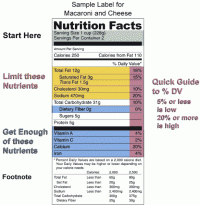Measuring Metric's Limits in the Grocery Aisle
The fight to persuade Americans to ditch English units for the metric system in their everyday lives is largely lost. And now even some advocates of grams, meters and the like want to make a tactical retreat from the site of one of their few victories: the grocery aisle.
The nutrition labels that have been mandated by the federal government for nearly 20 years list nutrient quantities in grams. A serving of cereal might be one-quarter cup, but that amount contains, say, 2.5 grams of fat and 4 grams of sugar.
Grams remain a foreign quantity to many Americans, who are more used to measuring weight in ounces and food ingredients in teaspoons or tablespoons. The result is that many may not really understand how much fat, protein and—in particular—sugar is in their food.
Americans foiled 1970s-era predictions of a national shift to metric, the collection of units such as kilograms and meters designed to be easily computed and scaled by factors of 10. That has left advocates of good science and good nutrition with a tough choice: use units on food labels that scientists applaud or ones that consumers easily understand.
"Americans have no idea about grams," says Michael Jacobson, executive director and co-founder of the Center for Science in the Public Interest, a Washington, D.C.-based advocacy group. His organization conducted a survey in 2010 that found 72% of Americans wanted to see sugar content measured in teaspoons on food labels, with more than half of those wanting to see grams jettisoned entirely. The organization recommended as much to the Food and Drug Administration, which is in the midst of redesigning the label it first introduced in 1993.
This is all somewhat painful to Mr. Jacobson, who sees widespread adoption of the same units used in science as part of the public interest. "I'm a metric advocate," he says. "I wish we went metric 30 years ago, but that wasn't to be."
One result of metric's failure to catch on here is reflected in the results of a survey released this past week by Consumer World, a consumer-information site. Edgar Dworsky, the site's founder and a former consumer-affairs official in Massachusetts, tested 721 readers of his site and electronic newsletter about their knowledge of grams. The survey showed them two nutritional labels for yogurt, identical except that one listed 25 grams of sugar, and the other six teaspoons. Fewer than half of those polled realized those were equivalent quantities, and most erred on the side of finding the 25 grams healthier.
It is hard to know if the amounts really are equivalent, because teaspoons measure volume and not all sugars are equally dense. But 4.2 grams of sugar per teaspoon is a widely cited conversion.
"It would be best if everyone knew the metric system and if there were no teaspoons or anything else around," says Lorelle Young, president of the U.S. Metric Association and a retired schoolteacher in Rancho Palos Verdes, Calif.
Critics of the metric system say English units live on because of their connection to real quantities: A foot is roughly the length of a man's foot, for instance. "Grams are the weight of a paper clip," says Seaver Leslie, a painter in Wiscasset, Maine, and founder of Americans for Customary Weight and Measure, a group that has opposed metrication of the country. "It's a very small, difficult unit of measure for human beings to perceive.
Tamara N. Ward, an FDA spokeswoman, says grams were chosen for sugar content on the current nutritional label to keep it consistent with fats and protein, and because a gram is a small unit, obviating potentially confusing fractions of an ounce. The agency is still reviewing comments on what the revised label should look like, she said.
The U.S. is in a hybrid state, with science and much of industry and government working in metric units while most consumers and consumer goods aren't. This tension is reflected in the nutrition label's use of grams, says Burkey Belser, president of Greenfield/Belser Ltd., the Washington, D.C., graphic-design company that designed the current nutritional label with the FDA.
"Grams are the vocabulary of scientists, not teaspoons or tablespoons, which are the vocabulary of cooks," says Mr. Belser.
The nutrition label does try to help the metric-averse, by listing the percentage of daily values of nutrients contained in a serving of food. Percentages have the virtue of transcending units: A food's percentage of the recommended daily value of protein is the same whether it is measured in grams or ounces. But because there is no scientific consensus on the appropriate daily value of sugars, there is no way to figure a percentage to include on food labels.
The Consumer World study asks whether "we push the public-policy component of the label even further, so it becomes crystal-clear that 25 grams of sugar equals six teaspoons of sugar," says Mr. Belser. "That's a great question."
—Learn more about this topic at WSJ.com/NumbersGuy. Email numbersguy@wsj.com.
A version of this article appeared Mar. 10, 2012, on page A2 in some U.S. editions of The Wall Street Journal, with the headline: Measuring Metric's Limits in the Grocery Aisle.
source: http://online.wsj.com/article/SB1000142405297020478180457726950416846881...
